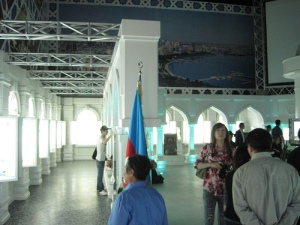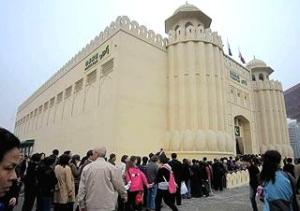THEME: At the Crossroads Between East and West
PAVILION: The façade of the Pavilion is colored in blue, gold and white and is meant to have a distinctive Eurasian look.
EXHIBIT: The interior of the Pavilion has the spacious feel of an Arabic home with light colors and an expansive open courtyard. Visitors enter past a display of Icheri Sheher, the Old City of Baku that is a UNESCO World Heritage Site and details the ongoing efforts to restore it and make it available as not only a tourist attraction but as a centerpiece of life in Baku. Around the outer walls of the interior are displays of Azerbaijan life and cities with a society going back 6,000 years in the region, showing artifacts of Stone Age civilizations as well as modern developments in science and technology. Cultural traditions are shown side by side with modernization projects, illustrating Azerbaijan’s traditional role as a conduit of treasure between East and West due to its position of strategic importance on the ancient Silk Road, and the country’s ambition to restore the Silk Road to its former use and prominence. In the center of the Pavilion, a large columnar kiosk and interactive electronic displays further inform visitors of the cultural traditions of Azerbaijan while they can also sit and enjoy performances of traditional folk music and dance.
CUISINE: There is no dining area listed for the Pavilion.
SHOPPING: There is no specific shopping facility listed for the Pavilion.
Note: This Pavilion was located in the Europe Joint Pavilion II
Filed under: Expo 2010 | Tagged: Arabic home, At the Crossroads Between East and West, Azerbaijan, Azerbaijan life, Azerbaijan Pavilion, Baku, centerpiece, China, columnar kiosk, conduit, cultural traditions, dance, displays, Eurasian, Expo 2010, facade, folk music, Icheri Sheher, interactive electronic displays, modern developments, modernization products, open courtyard, restoration, Shanghai, Silk Road, Stone Age civilizations, tourist attraction, UNESCO World Heritage site | Leave a comment »




